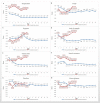Monitoring and Management of Home-Quarantined Patients With COVID-19 Using a WeChat-Based Telemedicine System: Retrospective Cohort Study
- PMID: 32568727
- PMCID: PMC7333794
- DOI: 10.2196/19514
Monitoring and Management of Home-Quarantined Patients With COVID-19 Using a WeChat-Based Telemedicine System: Retrospective Cohort Study
Abstract
Background: Most patients with coronavirus disease (COVID-19) who show mild symptoms are sent home by physicians to recover. However, the condition of some of these patients becomes severe or critical as the disease progresses.
Objective: The aim of this study was to evaluate a telemedicine model that was developed to address the challenges of treating patients with progressive COVID-19 who are home-quarantined and shortages in the medical workforce.
Methods: A telemedicine system was developed to continuously monitor the progression of home-quarantined patients with COVID-19. The system was built based on a popular social media smartphone app called WeChat; the app was used to establish two-way communication between a multidisciplinary team consisting of 7 medical workers and 188 home-quarantined individuals (including 74 confirmed patients with COVID-19). The system helped patients self-assess their conditions and update the multidisciplinary team through a telemedicine form stored on a cloud service, based on which the multidisciplinary team made treatment decisions. We evaluated this telemedicine system via a single-center retrospective study conducted at Tongji Hospital in Wuhan, China, in January 2020.
Results: Among 188 individuals using the telemedicine system, 114 (60.6%) were not infected with COVID-19 and were dismissed. Of the 74 confirmed patients with COVID-19, 26 (35%) recovered during the study period and voluntarily stopped using the system. The remaining 48/76 confirmed patients with COVID-19 (63%) used the system until the end of the study, including 6 patients whose conditions progressed to severe or critical. These 6 patients were admitted to hospital and were stabilized (one received extracorporeal membrane oxygenation support for 17 days). All 74 patients with COVID-19 eventually recovered. Through a comparison of the monitored symptoms between hospitalized and nonhospitalized patients, we found prolonged persistence and deterioration of fever, dyspnea, lack of strength, and muscle soreness to be diagnostic of need for hospitalization.
Conclusions: By continuously monitoring the changes in several key symptoms, the telemedicine system reduces the risks of delayed hospitalization due to disease progression for patients with COVID-19 quarantined at home. The system uses a set of scales for quarantine management assessment that enables patients to self-assess their conditions. The results are useful for medical staff to identify disease progression and, hence, make appropriate and timely treatment decisions. The system requires few staff to manage a large cohort of patients. In addition, the system can solicit help from recovered but self-quarantined medical workers to alleviate shortages in the medical workforce and free healthy medical workers to fight COVID-19 on the front line. Thus, it optimizes the usage of local medical resources and prevents cross-infections among medical workers and patients.
Keywords: COVID-19; home quarantine; progressive COVID-19 patients; quarantine management assessment; telemedicine system.
©Hui Xu, Sufang Huang, Chun Qiu, Shangkun Liu, Juan Deng, Bo Jiao, Xi Tan, Ling Ai, Yaru Xiao, Mirko Belliato, Li Yan. Originally published in the Journal of Medical Internet Research (http://www.jmir.org), 02.07.2020.
Conflict of interest statement
Conflicts of Interest: None declared.
Figures






References
-
- WHO Coronavirus Disease (COVID-19) Dashboard. World Health Organization. [2020-04-20]. https://covid19.who.int/
-
- Home care for patients with COVID-19 presenting with mild symptoms and management of their contacts. World Health Organization. 2020. Mar 17, [2020-03-17]. https://www.who.int/publications/i/item/home-care-for-patients-with-susp....
-
- Li Q, Guan X, Wu P, Wang X, Zhou L, Tong Y, Ren R, Leung KSM, Lau EHY, Wong JY, Xing X, Xiang N, Wu Y, Li C, Chen Q, Li D, Liu T, Zhao J, Liu M, Tu W, Chen C, Jin L, Yang R, Wang Q, Zhou S, Wang R, Liu H, Luo Y, Liu Y, Shao G, Li H, Tao Z, Yang Y, Deng Z, Liu B, Ma Z, Zhang Y, Shi G, Lam TTY, Wu JT, Gao GF, Cowling BJ, Yang B, Leung GM, Feng Z. Early Transmission Dynamics in Wuhan, China, of Novel Coronavirus-Infected Pneumonia. N Engl J Med. 2020 Mar 26;382(13):1199–1207. doi: 10.1056/NEJMoa2001316. http://europepmc.org/abstract/MED/31995857 - DOI - PMC - PubMed
Publication types
MeSH terms
LinkOut - more resources
Full Text Sources
Medical

